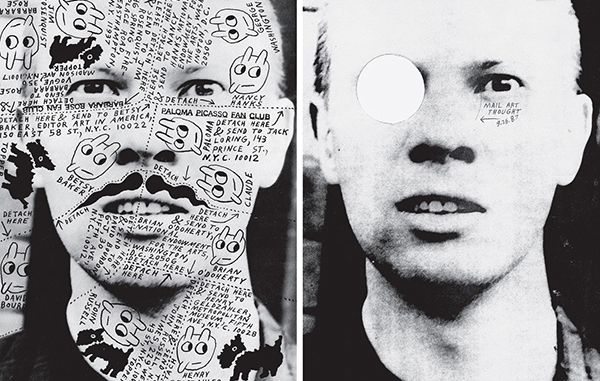RAYMOND “RAY” JOHNSON was an American artist who died on this date (b: 1927); Known primarily as a collagist and correspondence artist, he was a seminal figure in the history of Neo-Dada and early Pop art and was described as “New York’s most famous unknown artist”. Johnson also staged and participated in early performance art events as the founder of a far-ranging mail art network – the New York Correspondence School – which picked up momentum in the 1960s and is still active today. He is occasionally associated with members of the Fluxus movement but was never a member. He lived in New York City from 1949 to 1968, when he moved to a small town in Long Island and remained there until his suicide.
Johnson left Detroit after high school in the summer of 1945 to attend the progressive Black Mountain College (BMC) in North Carolina, where he stayed for the next three years (spending the spring 1946 semester at the Art Students League in New York but returning the following summer). Josef Albers, before and after his notable sabbatical in Mexico, was in residence at Black Mountain College for six of the ten semesters that Johnson studied there. Anni Albers, Walter Gropius, Lyonel Feininger, Robert Motherwell, Ossip Zadkine, Paul Rand, Alvin Lustig, Ilya Bolotowski, Jacob Lawrence, Beaumont Newhall, M. C. Richards, and Jean Varda also taught at BMC during Johnson’s time there.
Johnson decided on Albers’ advice to stay at BMC for a final term in summer 1948, when the visiting faculty included John Cage, Merce Cunningham, Willem de Kooning, Buckminster Fuller, and Richard Lippold. Johnson took part in “The Ruse of Medusa” – the culmination of Cunningham’s Satie Festival – with Cage, Cunningham, Fuller, Willem and Elaine de Kooning, Lippold, Ruth Asawa, Arthur Penn, and others among the cast and crew. “Because of those who participated, the event has taken on the reputation of a watershed event in ‘mixed media’ ” wrote Martin Duberman in his history of BMC.
By the mid-1950s he had destroyed much of his early work and was producing a type of collage he called “moticos” (a nonsensical anagram of the word “osmotic”), which could be hung on the wall, mailed in envelopes, or featured in impromptu performances. As the collages evolved and began to incorporate images of celebrities, including Elvis Presley, James Dean, and Shirley Temple, Johnson found himself at the forefront of what would become known as Pop Art. Later, by organizing and choreographing the activities of the NYCS, he participated in the burgeoning Fluxus movement whose interdisciplinary activities blurred the boundaries between art and everyday life. For the remainder of his career until his death in 1995, Johnson cultivated a position for himself that would be both inside and outside the art world: extraordinarily well-networked but critically savvy and always resistant to the structures and constraints of traditional art spaces.
The Art Institute of Chicago, steward since 2018–19 of the William S. Wilson Collection of Ray Johnson—a vast trove of letters, artworks, and ephemera that was once the official archive of the NYCS—is home to one of the world’s most complete and diverse collections of Johnson’s art, with special strengths in early works from the 1950s to 1960s.
On January 13, 1995, Johnson was seen diving off a bridge in Sag Harbor, Long Island, and backstroking out to sea. His body washed up on the beach the following day. Many aspects of his death involved the number “13”: the date; his age, 67 (6+7=13); the room number of a motel he had checked into earlier that day, 247 (2+4+7=13), etc. Some continue to speculate about a ‘last performance’ aspect of Johnson’s drowning. Hundreds of collages were found carefully arranged in his home. He left no will and his estate is now administered by Adler Beatty.
Following his suicide, filmmakers Andrew Moore and John Walter (in conjunction with Frances Beatty of Richard L. Feigen & Co.) spent six years probing the mysteries of Johnson’s life and art. Their collaboration yielded the award-winning documentary How to Draw a Bunny, released in 2002. The film includes interviews with artists Chuck Close, James Rosenquist, Billy Name, Christo and Jeanne-Claude, Judith Malina, and many others.
